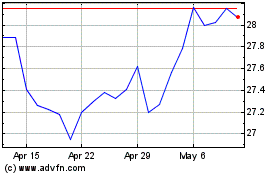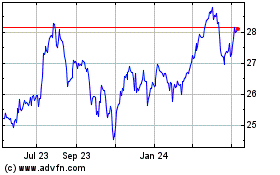Why Frontier Markets ETFs are Still Attractive - ETF News And Commentary
September 18 2013 - 8:00AM
Zacks
Emerging markets have
been in the limelight due to their stellar performance in the past
few years but they have lost their luster lately. So far in 2013,
many emerging markets suffered steep declines, mainly due to the
‘taper talk, which is making investors reconsider emerging markets
in general.
Beyond the taper, current account deficits and political woes have
also impacted these markets. Investors are growing concerned about
the political situation in many countries, in addition to rising
inflation and growing current account deficits.
Many nations in this space have seen their benchmarks fall by
double digits, pushing a number of developing nations into crash
territory. Lately, emerging country funds from India, Indonesia,
Thailand, Turkey and China have been struggling with weak numbers.
(Read: Time to Panic About Emerging Markets?)
On the other hand, many smaller emerging markets or frontier
markets have managed to remain rather unaffected by the turmoil in
the broader emerging markets space.
About Frontier Markets
Frontier markets include countries that are in the early stages of
economic development and are less established and developed than
emerging nations. When compared to emerging markets, frontier
markets have low market capitalization and liquidity (Read:
Frontier Markets: A Better Choice for ETF Investors?).
Moreover, frontier markets have a low correlation with the
developed markets which may benefit investors at a time when
investing in emerging nations isn’t fruitful. Further, they have
relatively lower valuations as well as higher income
yield.
One of the reasons for outperformance of frontier markets is the
currency factor. ETFs tracking frontier markets are dominated by
Middle East countries. Many of these countries peg their currencies
to the US dollar or to a basket dominated by the US dollar. As such
these currencies have remained steady while currencies of most
emerging markets have suffered a lot of pain. Currency losses have
been a big factor is emerging markets’ poor performance.
Further, during its latest classification review MSCI promoted UAE
and Qatar to emerging market status from frontier market. The
upgrade resulted in increase in capital flows to the Middle East
region.
Why should you play here?
Of late, frontier funds have amassed $1.5 billion in assets this
year in contrast to steep outflows for many of the largest emerging
market ETFs, reports Bank of America Merrill Lynch.
The space mostly benefits from the markets of Kuwait, Qatar and
United Arab Emirates (UAE) that are more focused on local demand
and are free from global market risks (Read: Time for Frontier
Markets ETFs?).
The Risks
Though the frontier markets provide a good investment strategy for
those looking for attractive returns over the long term, a high
level of volatility and poor liquidity are risks that run high in
these markets. High inflation levels are also a headwind, as many
have trouble keeping inflation under control.
How to play?
For investors who are willing to take some risk and seek to reap
the benefits, we have highlighted two ETFs which track broader
frontier markets space.
iShares MSCI Frontier 100 Index
(FM)
Launched in Sep 2012, FM tracks the MSCI Frontier Markets Index,
which is ranked by float adjusted market capitalization. It is one
of the most popular funds in the space and puts more focus in large
cap securities. The fund has an asset base of $286.3 million and
has an average daily trading volume of 115,000 shares a day.
The ETF holds 101 securities in its basket. The top ten holdings of
the fund take almost 39% share in the basket. In terms of
country exposure, Kuwait (25.75%), Qatar (19.02%) and the UAE
(14.74%) are in the top three spots. Financials dominates in terms
of sector exposure, accounting for a whopping 56% of the total
assets, while Telecommunication (14.15%) and Industrials (11.56%)
round out the top three.
The fund is a bit costly in the space, charging investors a hefty
fee of 79 bps. However, the fund has given strong returns of over
17% year to date and also pays a 30-day SEC yield of 4.09%.
PowerShares MENA Frontier Countries ETF
(PMNA)
Launched in Jul 2008, PMNA tracks the NASDAQ OMX Middle East North
Africa index, which seeks the performance of liquid companies in
MENA (Middle East and North Africa) frontier countries. So far, the
fund has amassed only $15.2 million in assets.
The fund holds 43 securities in its basket. The fund is more
concentrated in its top 10 holdings as it puts nearly 55% share.
Citadel Capital, National Bank of Kuwait and Union Land Development
Corp. are the top three company holdings of the fund.
The ETF is tilted more towards Financials as it leads the sector
with about 74% share, while
Telecom and Industrials allocate a respective 14% and 8%. In terms
of country exposure, Kuwait (23.53%), UAE (18.3%), Egypt (16.19%)
and Qatar (15.17%) account for the majority of asset holdings.
The product charge investors 70 bps in fees. The fund has generated
returns of 9.5% on a year-to-date basis and has a decent yield of
1.68% (Find all broad emerging markets
ETFs) .
Want the latest recommendations from Zacks Investment Research?
Today, you can download7 Best Stocks for the Next 30 Days.
Click to get this free report >>
ISHRS-MSCI F100 (FM): ETF Research Reports
PWRSH-MENA FRON (PMNA): ETF Research Reports
To read this article on Zacks.com click here.
Zacks Investment Research
Want the latest recommendations from Zacks Investment Research?
Today, you can download 7 Best Stocks for the Next 30 Days. Click
to get this free report
iShares Frontier and Sel... (AMEX:FM)
Historical Stock Chart
From Jan 2025 to Feb 2025

iShares Frontier and Sel... (AMEX:FM)
Historical Stock Chart
From Feb 2024 to Feb 2025
